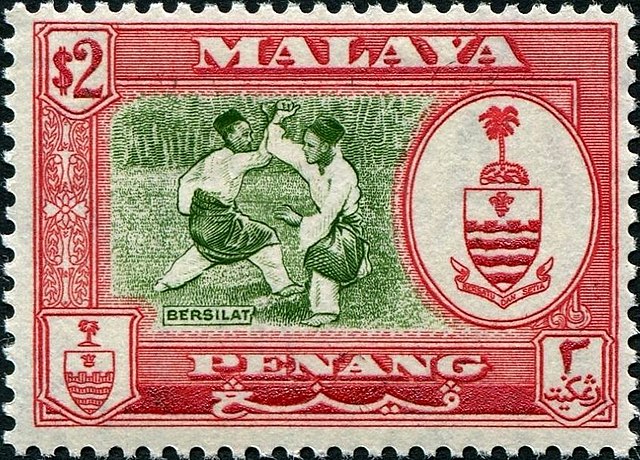Silat Melayu, also known as Seni Persilatan Melayu or simply Silat, is a combative art of self-defence from the Malay world, that employs langkah ('steps') and jurus ('movements') to ward off or to strike assaults, either with or without weapons. Silat traced its origin to the early days of Malay civilisation, and has since developed into a fine tradition of physical and spiritual training that embodies aspects of traditional Malay attire, performing art and adat. The philosophical foundation of modern Malay Silat is largely based on the Islamic spirituality. Its moves and shapes are rooted from the basis of Silat movements called Bunga Silat, and Silat performances are normally accompanied with Malay drum assembles.
A Malay Singaporean pesilat
A bronze mural of the legendary Laksamana Hang Tuah exhibited at the National Museum, Kuala Lumpur. He was a renowned exponent of martial arts, recounted today as an integral part of the cultural legacy of Silat.
Silat depicted on 1960 paper money
Demonstration by a pair of Malay Silat practitioners
Adat is a generic term derived from Arabic to describe a variety of local customary practices and traditions deemed compatible with Islam as observed by Muslim communities in the Balkans, North Caucasus, Central Asia, and Southeast Asia. Despite its Arabic origin, the term adat resonates deeply throughout Maritime Southeast Asia, where due to colonial influence, its usage has been systematically institutionalised into various non-Muslim communities. Within the region, the term refers, in a broader sense, to the customary norms, rules, interdictions, and injunctions that guide individuals' conduct as members of the community and the sanctions and forms of address by which these norms and rules are upheld. Adat also includes the set of local and traditional laws and dispute resolution systems by which these societies are regulated.
A bride and grooms wearing traditional Malay Deli wedding attire in front of the King's Throne at Maimun Palace.
Muslim men in the Caucasus
Group of Minangkabau people in adat dress, 1895







